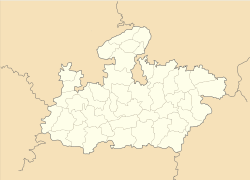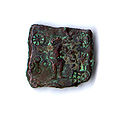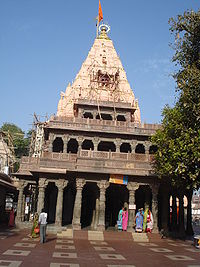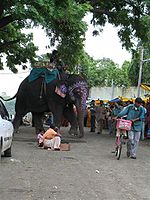- Ujjain
-
This article is about the municipality in Madhya Pradesh, India. For its namesake district, see Ujjain District.
Ujjain — city — Coordinates 23°10′58″N 75°46′38″E / 23.182778°N 75.777222°ECoordinates: 23°10′58″N 75°46′38″E / 23.182778°N 75.777222°E Country India State Madhya Pradesh District(s) Ujjain Population 429,933 (2001[update]) Time zone IST (UTC+05:30) Website http://ujjain.nic.in/ Ujjain (Hindi: उज्जैन)
 pronunciation (help·info) (also known as Ujain, Ujjayini, Avanti, Avantikapuri), is an ancient city of Malwa region in central India, on the eastern bank of the Kshipra River (Hindi: क्षिप्रा), today part of the state of Madhya Pradesh. It is the administrative centre of Ujjain District and Ujjain Division.
pronunciation (help·info) (also known as Ujain, Ujjayini, Avanti, Avantikapuri), is an ancient city of Malwa region in central India, on the eastern bank of the Kshipra River (Hindi: क्षिप्रा), today part of the state of Madhya Pradesh. It is the administrative centre of Ujjain District and Ujjain Division.In ancient times the city was called Ujjayini. As mentioned in the Mahabharata epic, Ujjayini was the capital of the Avanti Kingdom, and has been the Prime Meridian for Hindu geographers since the 4th century BCE. Ujjain is one of the seven sacred cities (Sapta Puri) of the Hindus, and the Kumbh Mela religious festival is held there every 12 years. It is also home to Mahakaleshwar Jyotirlinga, one of the twelve Jyotirlinga shrines to the god Shiva and is also the place where Lord Krishna got education with Balarama and Sudama from Maharshi Sandipani.
History of Ujjain
- Ujjain
The earliest references to the city, as Ujjaini, are from the time of the Buddha, when it was the capital of the Avanti Kingdom. Since the 4th century B.C. the city has marked the first meridian of longitude in Hindu geography. It is also reputed to have been the residence of Ashoka (who subsequently became the emperor), when he was the viceroy of the western provinces of the Mauryan empire.
In the Post-Mauryan period, the city was ruled by the Sungas and the Satavahanas consecutively. It was contested for a period between the Satavahanas and the Ror Sakas (devotees of Shakumbari), known as Western Satraps; however, following the end of the Satavahana dynasty, the city was retained by the Rors from the 2nd to the 4th century CE. Ujjain is mentioned as the city of Ozene in the Periplus of the Erythraean Sea, an antique Greek description of sea ports and trade centers in the western Indian Ocean. Following the enthroning of the Gupta dynasty, the city soon became an important seat in the annals of that empire. Ujjain is considered to be the traditional capital of King Chandragupta II, also known as Vikramaditya, at whose court the nine poets known as the navaratna (nine jewels) of Sanskrit literature are said to have flourished.
In the 10th and 11th centuries, Ujjain was a major centre of mathematical and astronomical research. The famous mathematicians who worked there included: Brahmagupta, whose book Brahmasphutasiddhanta was responsible for spreading the use of zero, negative numbers and the positional number system to Arabia and Cambodia; Varahamihira, who was the first to discover many trigonometric identities; and Bhaskaracharya, or Bhaskara II, whose book Lilavati broke new ground in many areas of mathematics.
Ujjain was invaded by the forces of the Delhi Sultanate led by Iltutmish in 1235, suffering widespread destruction and systematic desecration of temples. Under the Mughal emperor Akbar it became the capital of Malwa. During the last half of the 18th century Ujjain was the headquarters of the Maratha leader Scindia. The Scindias later established themselves at Gwalior, and Ujjain remained part of Gwalior state until Indian Independence in 1947. Gwalior state became a princely state of the British Raj after the Maratha defeat in the Third Anglo-Maratha War, and Gwalior, Ujjain, and the neighboring princely states were made a part of the Central India Agency. After Indian independence, the Scindia ruler of Gwalior acceded to the Indian Union, and Ujjain became part of the Madhya Bharat state. In 1956 Madhya Bharat was merged into the Madhya Pradesh state.
Ancient monuments and tourist sites in Ujjain
- The Mahakal Temple, one of the twelve Jyotirlingas, is a famous and venerated Shiva temple. The Shivling in this temple is supposed to be the only Jyotirling which faces south and hence it is known as Dakshinmukhi or the south-facing ling. It is the most popular and important temple of Ujjain. Every year on Shivratri (claimed to be the wedding day of Lord Shiva), there is a huge crowd of devotees for darshan. The same kind of public crowd can be seen in the month of Savaan, Nagpanchami. On every Monday of "Savan", there is a huge procession for the Lord Shiva idol in the city attended by large numbers of devotees from across the India.
- Mahakal derives its name from "kaal" meaning end of life - death; the word Mahakaal means Lord of Death.
- Sri Sri Radha Madan Mohan Temple, of the ISKCON (International Society for Krishna Consciousness) or Hare Krishna Movement, also has a guest house and restaurant, and is a major attraction for tourists, though it is very new on the map of Ujjain.
- The temple of Chintaman Ganesh is the biggest ancient temple of Lord Ganesha in Ujjain.
- The temple of Maa Wagheshvari is known for its tall idol of the goddess Wagheshwari and "Sinh (lion) - Dwar (gate)".
- The Harsidhhi Temple is one of the Shaktipeeth, situated at 52 places in India.
- The Sandipani Ashram is where tradition says Shri Krishna was educated with Balarama and Sudama from Maharshi Sandipani.
- The Siddha Ashram, located between Ramghat and Narshinghat, is known for research in Ayurvedic medicine and Kundalini Shaktipat.
- The Kaliyadeh Palace, located on the north of the city, is one of the palaces belonging to royal Scindia family of Madhya Pradesh.
- The Bharthari caves is an ancient site which has some interesting legends associated with it. It is said that it holds tunnels which lead directly to 4 ancient dhams (char dham). These ways were later shut down by Britishers.
- Canopy (Chhatri or Dewali) of Veer Durgadas Rathore "the Great Warrior and protector of Marwar" at Chakratirth.
- The Observatory (Vedha Shala) built by a Rajput king, Raja Jai Singh II, in the 1720s, is one of the five such observatories in India and features ancient astronomical devices.
- The Prashanti Dham is a holy place, where Sai Baba's Ashram is situated.
- Jain temples: Jai Singh Pura Atishay Kshetra, Tapobhoomi, Avanti Parshwanath, Hanumant Baag, Manibhadradham Bhairavgarh.
- The Kothi Palace presents a sight worth watching in the evening.
- The Bharatiya Vidya Bhavan museum, located near Chamunda tower, holds many ancient objects.
- The throne of Maharaja Vikramaditya, known as the "seat of judgment (salabanjika throne)" may be located in the Rudra Sagar lake.
- Other temples are Harsidhhi (Durga Temple), Gadh Kalika, Kaal Bhairav, Triveni (Nav Graha Shani Mandir), Mangalnaath, Siddhhanath and Shiv Shakti.
Image gallery
Among Seven Holy Cities of India
Moreover, Ujjain is one of seven most holy places for Hindus in India where Varanasi is considered as the holiest of the seven holy cities.
“ Ayodhyā Mathurā Māyā Kāsi Kāñchī Avantikā I Purī Dvārāvatī chaiva saptaitā moksadāyikāh II - Garuḍa Purāṇa I XVI .14
” A Kṣetra is a sacred ground, a field of active power, a place where Moksha, final release can be obtained. The Garuda Purana enumerates seven cities as giver of Moksha. They are Ayodhya, Mathura, Māyā, Kāsi, Kāñchī, Avantikā and Dvārāvatī.[1]
Various Names of Ujjain
Since Ujjain is one of the oldest cities in India, it has been known by many names:[2]
- Avantika
- Padmavati
- Kushasthali
- Bhagavati
- Haranyavati
- Kandakatringa
- Kumudvati
- Pratikalpa
- Ujjayani
- Udeni
- Vishala
It is said that to the Western astronomers it was known as "Arin".[citation needed]
Geography
Ujjain is situated on the Malwa Plateau in Central India. The soil is black and stony. The vegetation is typical of arid regions with thorny trees like babul and acacia dominating the landscape. Soybean, wheat, jowar and bajra are the main crops grown.
Ujjain is located at 23°10′58″N 75°46′38″E / 23.182778°N 75.777222°E.[3] It has an average elevation of 491 metres (1610 ft).
Demographics
As of 2001[update] India census,[4] Ujjain had a population of 429,933. Males constitute 52% of the population and females 48%. Ujjain has an average literacy rate of 72%, higher than the national average of 59.5%: male literacy is 79%, and female literacy is 66%. In Ujjain, 13% of the population is under 7 years.Ujjain city is spread on the area of 93 km2 and is 78th largest city in India and 5th in M.P.
Climate
Ujjain Climate chart (explanation) J F M A M J J A S O N D 192710430126351723921144025144362427430232232922146312129331843114142811Average max. and min. temperatures in °C Precipitation totals in mm Source: IMD Imperial conversion J F M A M J J A S O N D 0.781500.286540.295630.1102700.6104775.797751186738.884725.788701.191640.288570.68252Average max. and min. temperatures in °F Precipitation totals in inches Ujjain experiences a warm sub-tropical climate, typical of the interior Indian subcontinent. Summer starts in late March with temperatures rising to 45°C at its peak in May. In addition, hot winds (called loo) may blow in the afternoons, adding to the discomfort. The monsoon arrives in the middle of June and continues till early October. About 870mm (35 inches) of precipitation is received during those months.
The rest of October generally is very warm and with high humidity. Winter starts in the middle of November and is pleasant and cool with daytime temperatures typically 20°C, though temperatures can drop significantly in the night.
Administrative
Ujjain city has two legislative assembly zones, known as Ujjain North and Ujjain South. For Parliamentary purposes it is treated as one seat. There are 54 wards in ujjain. ward members are elected by peoples directly. At present oct. 2010 Mr. Rameshwar akhand of B.J.P. is mayor of Ujjain .
Economy
The economy of Ujjain is mainly dependent on the agricultural activities of the nearby villages. Two main crops are grown each year: wheat as the major Rabi crop, soybean as the major Kharif crop. Ujjain agriculture is sensitive to changes in rainfall and failure of monsoon cycles can lay a devastating toll on agriculture and the local economy.
Ujjain was previously a major industrial area having steel plant,soyabeen oil plant,shree synthetics ltd.and a dalda mill and was a great centre of the textile industry with a number of textile mills in the city. Almost all the mills have since closed. Religious tourism is also a contributor to the economy, especially during the Simhasta Mela.
A number of new infrastructure projects are under construction. SAIL has plans to operate a Special Processing Unit[5] from Ujjain to cater to regional supply. With cheaper land & labour costs Ujjain is creating enough attention for new investments.
Ujjain also generates huge revenue from the boost given to the economy by the holy fair of Kumbh Mela locally known as Simhastha.
Transport
Ujjain is well-connected by rail, air and road. It is on the Western Railway and is connected by direct train to most major Indian cities.Ujjain has an air strip. The nearest airport is Indore Airport.The road network is developed with other parts of Madhya Pradesh.Ujjain is connected to Indore through SH-27 and SH-18 Dewas-Badnawar passes through it. Unfortunately Ujjain is the largest city which has no national highway.
Railway Stations
There are four railway stations:
- Ujjain Junction main
- Vikram Nagar
- Chintaman (Metre Gauge)
- Pingleshwar
Bus Stations
- Dewas Gate(Shaheed Raja Bhau Mahakal bus stand)
- Nanakheda(Pt. Deendayal Upadhyay bus stand)
Major Roads
Kota - Indore Road, Dewas Road, Agar Road, Badnagar Road, Maksi Road, Nagda Road , Tarana Road Via Undasa Dam , Chintaman Road Connected to fourlane from Badnagar to Sanwer
Education
Primary and secondary education in Ujjain is offered by various schools which are affiliated to either Madhya Pradesh Board of Secondary Education or CBSE.
Ujjain is well known for its university, Vikram University which is the second oldest university in Madhya Pradesh, established in 1957. The city has one Government aided Engineering College, Ujjain Engineering College (UEC), which is the 5th best ranked college in Madhya Pradesh among all colleges and numerous privately run Engineering and Management institutes. Medical Colleges include Government aided Govt. Autonomous Dhanvantri Ayurveda College & privately held R.D. Gardi Medical College.Presently city has seven engineering ,one ayurved,one medical,one nursing college and two govt. organised universities.
84 Mahadeva (Shiva) of Ujjain
There are 84 Gods of Ujjain, Chaurasi Mahadev (Shiva), out of them four are the dwarapalas of Mahakala Ujjain. The four dwarapalas are Pingaleshwara (East), Kayavarohaneshwara (South), Vilveshwara (West) and Dardareshwara (North). The Chaurasi Ishwaras are:
References
- ^ The Hindu temple, Volume 1 By Stella Kramrisch, Raymond Burnier p.3
- ^ Room A. Placenames of the world: origins and meanings, p. 12.
- ^ Falling Rain Genomics, Inc - Ujjain
- ^ "Census of India 2001: Data from the 2001 Census, including cities, villages and towns (Provisional)". Census Commission of India. Archived from the original on 2004-06-16. http://web.archive.org/web/20040616075334/http://www.censusindia.net/results/town.php?stad=A&state5=999. Retrieved 2008-11-01.
- ^ SAIL Press Release. "Steel Minister lays foundation stone for SAIL's 4th steel processing unit", New Delhi,13 June 2008.
External links
- Official website of Ujjain
- Official website of Ujjain Yoga LIfe Society
- Ujjain buzz
- Mahakaleshwar Temple, Ujjain On India Tours
 Chisholm, Hugh, ed (1911). "Ujjain". Encyclopædia Britannica (11th ed.). Cambridge University Press.
Chisholm, Hugh, ed (1911). "Ujjain". Encyclopædia Britannica (11th ed.). Cambridge University Press.- [http://www.visitujjain.com /for detail information of ujjan}
Cities and towns in Ujjain Division Dewas district Mandsaur district Neemuch district Ratlam district Shajapur district Agar · Akodia · Badagoan · Badod · Kanad · Maksi · Polay Kalan · Shajapur · Shujalpur · Soyatkalan · SusnerUjjain district Related topics Cities and towns
in other DivisionsIndian mathematics Mathematicians AncientClassicalĀryabhaṭa I · Āryabhaṭa II · Bhāskara I · Bhāskara II · Melpathur Narayana Bhattathiri · Brahmadeva · Brahmagupta · Brihaddeshi · Halayudha · Jyeṣṭhadeva · Mādhava of Sañgamāgrama · Mahāvīra · Mahendra Sūri · Munishvara · Parameshvara · Achyuta Pisharati · Jagannatha Samrat · Nilakantha Somayaji · Śrīpati · Sridhara · Gangesha Upadhyaya · Varāhamihira · Sankara Variar · VirasenaModernShreeram Shankar Abhyankar · A. A. Krishnaswami Ayyangar · Amiya Charan Banerjee · Raj Chandra Bose · Satyendra Nath Bose · Harish-Chandra · Subrahmanyan Chandrasekhar · D. K. Ray-Chaudhuri · Sarvadaman Chowla · Narendra Karmarkar · Prasanta Chandra Mahalanobis · Jayant Narlikar · Vijay Kumar Patodi · Srinivasa Ramanujan · Calyampudi Radhakrishna Rao · S. N. Roy · Sharadchandra Shankar Shrikhande · Navin M. Singhi · Mathukumalli V. Subbarao · S. R. Srinivasa VaradhanTreatises Āryabhaṭīya · Bakhshali manuscript · Brāhmasphuṭasiddhānta · Karanapaddhati · Paulisa Siddhanta · Paitamaha Siddhanta · Romaka Siddhanta · Sadratnamala · Śulba Sūtras · Surya Siddhanta · Tantrasamgraha · Vasishtha Siddhanta · Veṇvāroha · Yuktibhāṣā · YavanajatakaCenters Influences Influenced Categories:- Ujjain
- Hindu holy cities
- Hindu pilgrimage sites
- Populated places along the Silk Road
- Railway stations in Madhya Pradesh
Wikimedia Foundation. 2010.














